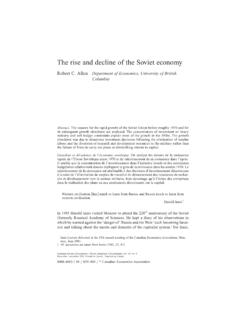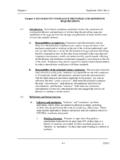Transcription of 1 Unit 01. Introduction to Taxation - University of Utah
1 The first chapter in PAK outlines the basic purposes and principles of Taxation . This is an overview chapter. Read it with the goal of gaining a broad understanding of tax purposes and principles. Although the history is interesting, for Unit 01. Introduction to Taxation1with the goal of gaining a broad understanding of tax purposes and principles. Although the history is interesting, for our purposes, the sections on tax structure, types of tax, tax administration, and understating the tax law will be relatively more efficiency and space reasons textbook examples are not copied to the slides. Instead, you are asked to study specific examples in the textbook when you read through the slides at various points.
2 These example-study notes are highlighted in History of Taxation in the United States Types of tax rate structures Other type of taxes Criteria for a tax structureObjectives of the federal income tax law2 Objectives of the federal income tax law Entities in the federal income tax system Tax law sources Enactment of tax law Administration of the tax law and tax practice issues Components of a tax practiceHistory of TaxationEarly Periods First federal income tax levied in 1861 to fund Civil war. It was repealed after the war. Federal income tax reinstated in 1894, but challenged in court. In 1895, Supreme Court ruled income tax unconstitutional! 3in court. In 1895, Supreme Court ruled income tax unconstitutional!
3 Constitution amended in 1913; 16thamendment gives Congress right to tax income. The Congress shall have the power to lay and collect taxes on incomes, from whatever source derived, without apportionment among the several States and without regard to any census or of Taxation Revenue Acts from 1913 to the Present Early tax rates were relatively low and high exemption levels effectively exempt most of the US population from paying taxes. In 1939, less than 6% of US population paid a federal income tax. 4federal income tax. Due to need for increased government revenue to fund World War II, tax base was broadened so that by 1945, 75% of the US population paid federal income tax. Pay as go withholding was added in 1943.
4 History of TaxationRevenue Sources5 History of TaxationRevenue Sources Individual income taxes comprise almost of the revenue received by the federal government. This share has held fairly steady over time. Social insurance taxes and contribution comprise 6 Social insurance taxes and contribution comprise about another third. This share has increased 18 percentage points since 1960. Corporate income taxes provide about 13% of government revenue. This share has decreased 10 percentage points sine Breakdown of Federal Revenues: 1960-20087 Two Basic Components of Tax Structures Tax base: The amount to which tax rate is applied to determine the tax due. Example: taxable income8 Tax rate: The percentage rate applied to the tax baseTypes of Tax Rate StructuresIndividual Income Tax Rates Possible tax rate structures are Progressive: Rate increases as tax base increases, such as the current income tax.
5 Study Example1-1 and 1-2 on Page 1-4 Proportional (flat tax): Rate is the same regardless of tax base, such as sales tax Study Example 1-3 on Page 1-49 Study Example 1-3 on Page 1-4 Regressive: Rate decreases as tax base increases, such as the current FICA tax (Social security and Medicare tax) Study self-study question on Page 1-5 The current federal income tax system is mildly progressive (10%-35%). The benefits of personal and dependency exemptions are phased-out for upper-income taxpayers. Also, upper-income taxpayers will lose some benefit for certain itemized of Tax Rate StructuresIndividual Income Tax Rates for 2009 For 2009 the federal income tax rate begins at 10% to increase to 15%, 25%, 28%, 33%, and 35%.
6 For details see the inside front cover of 10inside front cover of the PAK textbook, or visit IRS website at The two tables on the right show the tax rates for two filing statuses as of Tax Rate Structures Corporate Tax Rates The tax rates for regular corporations (C corporations) are also mildly progressive (varying between 15% and 39%). A surcharge is applicable to high corporate taxable income. The stair-step pattern of progression tends to benefit small corporations Benefit of graduated tax rates phased out between $100K and $335K, and $15M and $ of graduated tax rates phased out between $100K and $335K, and $15M and $ of Tax Rate StructuresMarginal, Average, and Effective Tax Rates Marginal tax rate most useful rate in tax planning Tax rate applied to incremental amount of taxable income that is added to tax base.
7 Study Example 1-4 on Page 1-5 Average tax rate Total tax liability divided by amount of taxable income Study Example 1-5 on Page 1-6 Effective tax rate13 Study Example 1-5 on Page 1-6 Effective tax rate Total tax liability divided by total economic income Study Example 1-5 on Page 1-6 The marginal, average, and effective tax rates may vary significantly from the nominal schedule rates. For example, even though the nominal maximum individual rate is 35%, the marginal rate will be increased by any phase-out of exemptions or itemized of Tax Rate StructuresDetermination of Taxable Income and Tax Due Taxable income for all types of taxpayers is calculated by subtracting allowable exclusions, deductions, and exemptions from total income.
8 The tax or refund due is Gross Income -Deductions forAGI = AGI - Deductions fromAGI=Taxable Income14income. The tax or refund due is calculated by subtracting allowable credits and/or prepayments from the gross tax liability resulting from applying applicable tax rates times taxable IncomexIndividual Tax Rate= Gross Tax Due-Credits & Payments=Tax or Refund DueOther Types of Taxes State and local income taxes State and local franchise taxes Wealth transfer taxes Estate tax Covered in FCS 5540 Estate Tax Planning Gift tax: Tax imposed on the donorfor transfer of property that is considered a taxable tax: Tax imposed on the donorfor transfer of property that is considered a taxable gift. $13,000 annual exclusion per donee Unlimited marital deduction for transfer between spouses Charitable gifts are exempt unlimited deduction Study Example 1-6 on Page 1-8 and 1-9 Other types of taxes Property, excise, sales, & employment taxesCriteria for a Tax StructureHow to judge whether a tax structure is good ?
9 Equity: How fair is the tax structure? Problem: Fairness is very subjective! Vertical equity: Taxpayers who are not situated similarly should be treated differently. Horizontal equity: Similarly situated taxpayers should be treated the same. Certainty Stable source of government revenuesAmount of liability for taxpayers16 Amount of liability for taxpayers Convenience -Easily assessed, collected, and administered Economy Minimal compliance and administration costs Businesses spent $148 Bto comply with federal tax law and $80B to comply with state and local taxes Cost to individuals $111B Simplicity -Should not be overly complexObjectives of Federal Income Tax Law Economic Objectives: Raise Revenues for Government Operations Stimulate Private Investment Reduce unemployment Mitigate Effects on InflationSocial Objectives: 17 Social Objectives.
10 Encouragement of certain activities and industries Encourage corporate research activities by tax write-offs Encourage charitable contributions (tax deductible) Study Example 1-11 on Page 1-15 Income tax reform proposals (Advisory Panel Report in 2005) Simplified Income Tax Plan (SITP) Growth and Investment Tax Plan (GITP)Entities in Federal Income Tax SystemTaxpaying Entities Various entities in the federal income tax system may be classified into two general categories: taxpaying entitiesand flow-through entities. Taxpaying entities: Directly pay income tax Individuals Taxable income = Total income Exclusions Deductions for AGI Deductions from AGI18 Taxable income = Total income Exclusions Deductions for AGI Deductions from AGI Study Example 1-13 on Page 1-18 to see how individual tax is computed C corporations (regular corporations) Taxable income = Total income Exclusions Deductions Study Example 1-14 on Page 1-19 to see how a C corporation tax is calculated.











